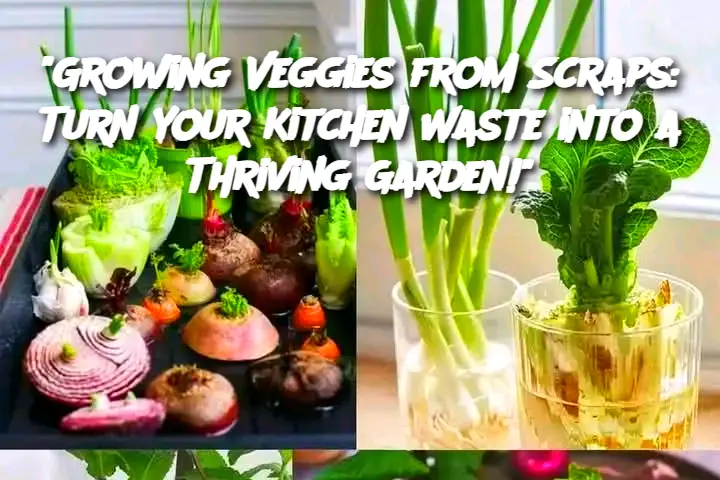ADVERTISEMENT
Introduction:
If you're looking to reduce food waste and grow fresh produce at home, why not try growing vegetables from kitchen scraps? Many of the vegetables we typically discard can easily be regrown into thriving plants with just a little care. This sustainable gardening method not only helps you cut down on waste but also gives you a fun, cost-effective way to enjoy fresh veggies straight from your garden. In this article, we’ll explore which veggies you can regrow from scraps, step-by-step instructions, and tips for success.
Ingredients (or Vegetables You Can Grow from Scraps):
Green Onions: The root ends of green onions can be regrown into new stalks.
Potatoes: Leftover potato pieces with "eyes" can be sprouted into new potatoes.
Lettuce & Celery: The bases of these veggies can sprout new leaves.
Carrots: You can regrow carrot greens from the tops, though the roots themselves will not regrow.
Garlic: A garlic clove can sprout new garlic shoots.
Tomatoes: Tomato seeds can be saved and grown into new plants.
Ginger: A piece of ginger with a bud can be regrown into fresh ginger root.
Herbs: Basil, cilantro, and mint can be regrown from their cuttings.
Directions:
Green Onions:
Cut the green onions about 2 inches above the roots.
Place the roots in a glass with enough water to cover them.
Place the glass in a sunny spot and change the water every few days.
In about 7-10 days, you'll see fresh green shoots growing!
Potatoes:
Cut your leftover potato into pieces, making sure each piece has at least one "eye" (a small bud).
Let the pieces sit for a day or two to form a protective callus on the cut sides.
Plant the pieces in well-drained soil, burying them about 4 inches deep.
Water consistently and in a few months, your potato plants will be ready to harvest.
Lettuce & Celery:
For lettuce, place the base of the lettuce in a shallow dish with enough water to cover the roots.
For celery, place the bottom of the stalk in a similar dish.
Keep the water level consistent and change the water every few days.
After about 2-3 weeks, you will see new growth emerging from the center.
Carrots:
Cut the top off a carrot, leaving about an inch of the top with the crown intact.
Place it in a shallow dish with water covering the top.
Within a few weeks, you will see green shoots growing, although the actual carrot won't regrow.
Garlic:
Take a garlic clove and place it in a small container with the root end facing down.
Add a little water to the container and place it in a sunny location.
After about 2 weeks, small green shoots will start to grow.
Tomatoes:
After eating a tomato, scoop out the seeds and let them dry for a few days.
Plant the dried seeds in a small container with soil.
Keep the container in a sunny spot, and you should see new tomato plants in a few weeks.
Ginger:
Take a piece of ginger with a visible bud and place it in a container with soil.
Water lightly, and keep the soil moist but not waterlogged.
Place the container in a warm, sunny spot, and you’ll have new ginger growing in a few months.
Herbs:
Cut a few stems of your favorite herbs, such as basil or mint.
Place them in a glass of water and leave them in a sunny spot.
After a couple of weeks, roots will begin to grow, and you can transplant them into soil.
Serving and Storage Tips:
Green onions: Can be snipped off as needed and stored in the refrigerator. The regrown stalks will continue to grow and be ready for use.
Potatoes: Once they’ve been harvested, store them in a cool, dark place. Be sure to allow them to cure for a few days after harvesting.
Lettuce & Celery: Can be harvested as needed, and regrown stalks can be kept in the fridge.
Carrots: While the greens make a great garnish, the roots won't regrow, so it’s best to consume them right away.
Garlic: You can snip the garlic shoots to use as fresh garlic chives, while the bulb can be harvested later.
Tomatoes: Once your tomato plant starts producing fruit, store the tomatoes at room temperature for the best flavor.
Ginger: Store fresh ginger in the fridge and use the roots as needed in cooking.
Herbs: Once your herbs are established, trim them regularly to keep them healthy, and store fresh leaves in the fridge or dry them for future use.
Variations:
ADVERTISEMENT
